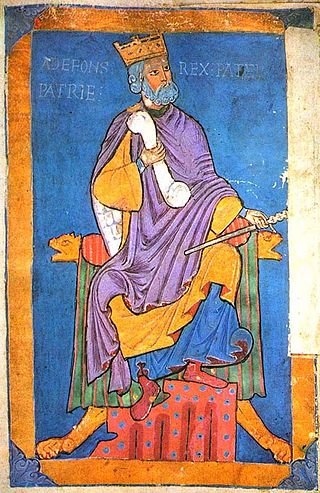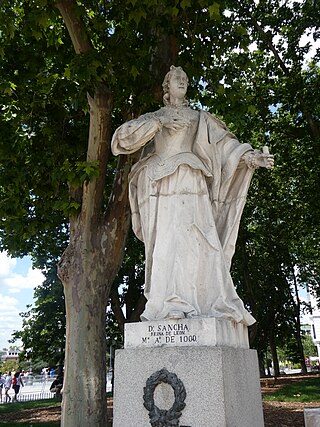
Alfonso V, called the Noble, was King of León from 999 to 1028. Like other kings of León, he used the title emperor to assert his standing among the Christian rulers of Spain. He succeeded his father, Bermudo II, in 999. His mother Elvira García and count Menendo González, who raised him in Galicia, acted as his co-regents. Upon the count's death in 1008, Alfonso ruled on his own.

Alfonso VI, nicknamed the Brave or the Valiant, was king of León (1065–1109), Galicia (1071–1109), and Castile (1072–1109).

Henry II, called Henry of Trastámara or the Fratricidal, was the first King of Castile and León from the House of Trastámara. He became king in 1369 by defeating his half-brother Peter the Cruel, after numerous rebellions and battles. As king he was involved in the Fernandine Wars and the Hundred Years' War.

García Sánchez II, was King of Pamplona and Count of Aragon from 994 until his death c. 1000. He was the eldest son of Sancho II of Pamplona and Urraca Fernández and the second Pamplonese monarch to also hold the title of count of Aragon. Modern historians refer to him as the Tremulous, though this appellation likely originally applied to his grandfather, García Sánchez I of Pamplona.

Leonor (Eleanor) de Guzmán y Ponce de León (1310–1351) was a Castilian noblewoman. After about 1330, she became the long-term mistress and favourite of Alfonso XI, with whom she had the illegitimate son Henry "the Fratricidal", future first monarch of the House of Trastámara. She held the lordship of Medina-Sidonia until she fell from grace in the wake of Alfonso's death in 1350. She was then executed by her enemies.
Bermudo III or Vermudo III was the king of León from 1028 until his death. He was a son of Alfonso V of León by his first wife Elvira Menéndez, and was the last scion of Peter of Cantabria to rule in the Leonese kingdom. Like several of his predecessors, he sometimes carried the imperial title: in 1030 he appears as regni imperii Ueremundo principis; in 1029/1032 as imperator domnus Veremudius in Gallecia; and in 1034 as regni imperii Veremundus rex Legionensis. He was a child when he succeeded his father. In 1034 he was chased from his throne by King Sancho III of Pamplona and forced to take refuge in Galicia. He returned to power, but was defeated and killed fighting against his brother-in-law, Ferdinand of Castile, in the battle of Tamarón.

Alonso Pérez de Guzmán (1256–1309), known as Guzmán el Bueno, was a Spanish nobleman and hero of Spain during the medieval period, the founder of the line from which the Dukes of Medina Sidonia descend.

Sancha of León was a princess and queen of León. She was married to Ferdinand I, the Count of Castile who later became King of León after having killed Sancha's brother in battle. She and her husband commissioned the Crucifix of Ferdinand and Sancha.
The Spanish Gypsy is an English Jacobean tragicomedy, dating from around 1623. The play was likely a collaboration between several dramatists, including Thomas Middleton, William Rowley, Thomas Dekker, and John Ford. Like Shakespeare's lost play Cardenio, The Spanish Gypsy is an English reworking of the novellas of Miguel de Cervantes, combining two of Cervantes' Novelas Ejemplares into a single drama.

María Alfonso Téllez de Meneses, known as María de Molina, was queen consort of Castile and León from 1284 to 1295 by marriage to Sancho IV of Castile, and served as regent for her minor son Ferdinand IV and later her grandson Alfonso XI of Castile (1312-1321).
Teresa Fernández de Traba was the Queen consort of León (1178–1180) during the reign of Ferdinand II.

Spanish Baroque literature is the literature written in Spain during the Baroque, which occurred during the 17th century in which prose writers such as Baltasar Gracián and Francisco de Quevedo, playwrights such as Lope de Vega, Tirso de Molina, Calderón de la Barca and Juan Ruiz de Alarcón, or the poetic production of the aforementioned Francisco de Quevedo, Lope de Vega and Luis de Góngora reached their zenith. Spanish Baroque literature is a period of writing which begins approximately with the first works of Luis de Góngora and Lope de Vega, in the 1580s, and continues into the late 17th century.

Urraca of Zamora was a Leonese infanta, one of the five children of Ferdinand I the Great, who received the city of Zamora as her inheritance and exercised palatine authority in it. Her story was romanticized in the cantar de gesta called the Cantar de Mio Cid, and Robert Southey's Chronicle of the Cid. Urraca's mother was Sancha of León.

Manrique Pérez de Lara was a magnate of the Kingdom of Castile and its regent from 1158 until his death. He was a leading figure of the House of Lara and one of the most important counsellors and generals of three successive Castilian monarchs: Alfonso VII (1126–57), Sancho III (1157–58) and Alfonso VIII (1158–1214).

Garci Lasso de la Vega II, also known as “El Joven” was the son of Garci Lasso de la Vega "El Viejo" with his first wife, Juana de Castañeda. He commanded Castillian troops against Navarra in the Battle of Río Salado of 1334. After distinguishing his valor, he was appointed as the highest royal official to the court of Fadrique Alfonso de Castilla, master of the Order of Santiago and son of Alfonso XI of Castile. He was later appointed Adelantado of Castile through the patronage of Juan Núñez de Lara. After the death of his patron, he sought refuge in Burgos, fearing the wrath of Juan Alfonso de Alburquerque. King Peter the Cruel and his henchmen captured him there where he suffered an atrocious death witnessed by the king in 1351, as reported by Pero López de Ayala in his chronicle on the reign of this monarch.

Pedro Ruiz de Villegas y Cevallos II was a Spanish noble baron in the service of the Kingdom of Castile and a member of the Order of Santiago. He was the head of the House of Villegas and a descendant of the houses of Cevallos and of Lucio. As the majorat of his own heraldic crest, he received titles over Villegas, Manquillos, Castillo Pedroso, Moñux, Pedrosa del Páramo, Manciles, Valdegómez and the palace of Sasamón. For his service in the First Castilian Civil War, and his role in the destruction of the Blanche of Bourbon league he received the castle of Caracena, and was named high adelantado of Castile in 1354. A year later, Peter of Castile would execute him in the village of Medina del Campo.
Alfonso Téllez de Meneses, known as el Viejo, was a nobleman of Castile and a participant in the key Reconquista battle of Las Navas de Tolosa. He was the second Lord of Meneses, Lord of Cea, Grajal, Montalbán, and, through his second wife, first Lord of Alburquerque.

Gutierre Rodríguez de Castro also known as Gutierre Ruiz de Castro and nicknamed el Escalabrado was a Castilian nobleman, member of the House of Castro as the son of Rodrigo Fernández de Castro and his wife Elo Álvarez, daughter of Álvar Fáñez and his wife Mayor Pérez, daughter of Count Pedro Ansúrez.
The Banu Gómez were a powerful but fractious noble family living on the Castilian marches of the Kingdom of León from the 10th to the 12th centuries. They rose to prominence in the 10th century as counts in Saldaña, Carrión and Liébana, and reached their apogee when, allied with Córdoba warlord, Almanzor, their head, García Gómez, expelled king Vermudo II of León and briefly ruled there. He would reconcile with the royal family, but launched two subsequent rebellions. On his death, the senior line of the family was eclipsed, but a younger branch would return to prominence, producing Pedro Ansúrez, one of the premier noblemen under king Alfonso VI and queen Urraca in the late 11th and early 12th centuries. The family would be portrayed in the Cantar de Mio Cid as rivals and antagonists of the hero, El Cid, and their rebellions would serve as a basis for the legend of Bernardo del Carpio.
Alberta was the queen consort of King Sancho II of Castile (1065–1072).